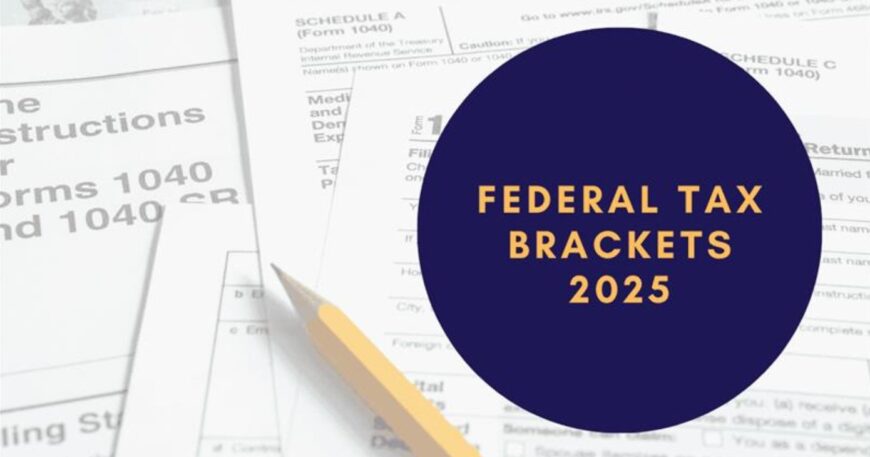Introducton
The landscape of federal taxes in the United States is always evolving. With each passing year, the tax brackets change, reflecting adjustments for inflation and shifts in the national economy. As we look forward to 2024 and 2025, it’s important to understand how these changes in federal tax brackets will impact your finances.
In this guide, we will break down the 2024 and 2025 federal tax brackets, explain how they work, and offer some tips on how you can plan for these changes effectively. Whether you’re filing as a single individual, married couple, or head of household, understanding these tax brackets will help you make more informed decisions about your tax strategy.
What Are Federal Tax Brackets?
Federal tax brackets are ranges of income that are taxed at different rates by the U.S. government. The idea behind this system is that the more you earn, the higher your income tax rate will be. However, tax brackets are progressive, meaning that only the income that falls within a specific range is taxed at that rate, not all of your income. This ensures that individuals with higher incomes pay a greater share of taxes while still benefiting from lower rates on the portion of their income that falls within lower tax brackets.
For example, if you’re in a 22% tax bracket, it means you only pay 22% on the portion of your income that falls within that range, not on your entire income.
Understanding the 2024 Federal Tax Brackets
The IRS adjusts the tax brackets annually to account for inflation, so let’s take a closer look at the tax brackets for 2024. Here’s a breakdown of the 2024 federal tax brackets for various filing statuses:
Single Filers:
- 10%: Up to $11,000
- 12%: $11,001 to $44,725
- 22%: $44,726 to $95,375
- 24%: $95,376 to $182,100
- 32%: $182,101 to $231,250
- 35%: $231,251 to $578,100
- 37%: Over $578,100
Married Filing Jointly:
- 10%: Up to $22,000
- 12%: $22,001 to $89,450
- 22%: $89,451 to $190,750
- 24%: $190,751 to $364,200
- 32%: $364,201 to $462,500
- 35%: $462,501 to $693,750
- 37%: Over $693,750
Head of Household:
- 10%: Up to $15,700
- 12%: $15,701 to $59,850
- 22%: $59,851 to $95,400
- 24%: $95,401 to $182,100
- 32%: $182,101 to $231,250
- 35%: $231,251 to $578,100
- 37%: Over $578,100
These updated brackets mean that many taxpayers will see their tax liability shift, depending on their income. It’s important to keep in mind that these tax brackets apply to your taxable income, which is your gross income minus deductions, exemptions, and credits.
What’s New for 2025: Projected Federal Tax Brackets
Looking ahead to 2025, the IRS will once again update tax brackets for inflation. Though these figures aren’t finalized yet, we can expect them to be slightly higher than those in 2024, due to ongoing inflation adjustments. The goal is to ensure that taxpayers’ purchasing power remains the same as inflation increases.
The 2025 tax brackets will likely reflect modest increases in the upper thresholds of each bracket, meaning that many Americans will see their taxable income fall into slightly higher brackets. This could reduce the tax burden for those earning in the middle income ranges while also offering slight relief for high earners.
While the exact numbers for 2025 aren’t available yet, it’s crucial to stay up-to-date on these changes. Tax planning becomes essential as the IRS announces these adjustments, allowing you to adapt and make any necessary modifications to your tax strategies before the year ends.
| Tax Rate | Single Filers | Married Filing Jointly |
|---|---|---|
| 12% | $11,926 – $48,475 | $23,851 – $96,950 |
| 22% | $48,476 – $103,350 | $96,951 – $206,700 |
| 24% | $103,351 – $197,300 | $206,701 – $394,600 |
| 32% | $197,301 – $250,525 | $394,601 – $501,050 |
How the Federal Tax Brackets Impact Your Taxes
Understanding federal tax brackets is crucial because they directly affect how much you will owe in taxes each year. Let’s break down how the brackets impact your overall tax liability:
Progressive Tax System:
As mentioned earlier, the U.S. tax system is progressive. This means that as your income increases, your tax rate increases. However, it’s important to note that your entire income is not taxed at the highest rate you qualify for. Instead, only the portion that falls within a specific bracket is taxed at that rate.
Taxable Income and Deductions:
Your taxable income is what is subject to tax. This includes all your income, such as wages, interest, dividends, and other earnings, minus any deductions or credits you qualify for. Common deductions include the standard deduction or itemized deductions, which can reduce your taxable income and lower your overall tax liability.
Impact of Filing Status:
Your filing status plays a significant role in determining which tax bracket you fall into. For instance, if you’re married and filing jointly, you’ll benefit from higher income thresholds compared to someone filing as a single individual. Understanding your filing status and how it impacts your tax bracket is essential for maximizing your potential deductions and minimizing your tax burden.
Strategies to Reduce Your Tax Liability
Given that tax brackets can impact how much you owe, it’s important to develop strategies that can help reduce your tax liability. Here are a few common strategies:
Contribute to Retirement Accounts:
One of the most effective ways to reduce taxable income is to contribute to retirement accounts such as 401(k)s or IRAs. Contributions to these accounts are often tax-deductible, meaning they lower your taxable income and, in turn, your overall tax liability.
Tax Credits and Deductions:
Make sure you’re taking full advantage of available tax credits and deductions. Credits, such as the Child Tax Credit, or deductions, such as mortgage interest, can reduce your tax liability on a dollar-for-dollar basis. Consult a tax professional to see which credits and deductions you may be eligible for.
Plan for Long-Term Tax Benefits:
Consider tax planning strategies that can benefit you in the long term. For example, certain investments, like municipal bonds, may offer tax-free interest income. Additionally, long-term capital gains (on investments held for over a year) are often taxed at a lower rate than short-term gains.
Federal Tax Brackets FAQs
What are federal tax brackets?
Federal tax brackets are ranges of income that are taxed at different rates. The system is progressive, meaning the more you earn, the higher the tax rate you pay on income within a specific range.
What are the 2024 federal tax brackets?
The 2024 federal tax brackets range from 10% to 37% depending on your filing status. For example, single filers will pay 10% on income up to $11,000, while married couples filing jointly will pay 10% on income up to $22,000.
How will the 2025 federal tax brackets differ from 2024?
The 2025 federal tax brackets will likely be slightly higher due to inflation adjustments. This could lead to a small reduction in tax liability for many taxpayers.
How do tax brackets affect my tax return?
Tax brackets determine how much you will owe in taxes based on your taxable income. The higher your income, the higher the tax rate on the portion of your income that falls within each bracket.
What can I do to reduce my tax liability?
To reduce your tax liability, consider contributing to retirement accounts, taking advantage of tax credits and deductions, and engaging in long-term tax planning strategies.
Do tax brackets change every year?
Yes, tax brackets are adjusted annually by the IRS to account for inflation and changes in the economy. Be sure to stay updated on these changes each year.
Conclusion
The federal tax brackets for 2024 and 2025 are crucial to understanding how much you will pay in taxes. By staying informed about these changes, you can make smarter financial decisions and implement strategies to minimize your tax liability. Whether you’re filing as a single individual, married couple, or head of household, understanding tax brackets is the first step toward optimizing your tax strategy.
Why Choose Syed Professional Services?
Syed Professional Services stands out because of its dedication to providing top-notch, personalized services tailored to meet the unique needs of each client. Whether you’re looking for expert financial advice, tax solutions, or business consulting, Syed Professional Services offers comprehensive expertise in these areas, making it an ideal choice for individuals and businesses alike. The team is committed to delivering high-quality, results-driven services that not only meet but exceed client expectations.
What sets Syed Professional Services apart is its focus on building strong, long-term relationships with clients. Their reputation for professionalism, integrity, and reliable support has earned them the trust of many. This means when you choose Syed Professional Services, you’re not just getting a service; you’re gaining a trusted partner who has your best interests in mind.
What Can Syed Professional Services Do for You?
Syed Professional Services offers a wide range of services that can benefit both individuals and businesses. Here are some of the key offerings:
- Tax Services and Planning
Syed Professional Services provides expert tax planning and preparation, ensuring that you navigate the complexities of federal and state tax regulations smoothly. Whether you’re an individual or a business owner, they help optimize your tax strategy, minimize liabilities, and ensure compliance. - Business Consulting
They offer strategic advice to help businesses improve their operations, optimize efficiency, and scale effectively. Whether you’re looking to start a new business or improve an existing one, Syed Professional Services provides actionable insights that drive growth and profitability. - Financial Advisory
Syed Professional Services assists individuals and businesses with financial planning, investment strategies, and retirement planning. Their expert advisors can help you make informed decisions that secure your financial future, providing personalized recommendations based on your goals. - Compliance and Regulatory Services
With changing regulations, staying compliant can be a challenge. Syed Professional Services offers services to ensure your business adheres to local, state, and federal regulations, helping you avoid penalties and legal issues. - Personalized Customer Service
Their focus on delivering tailored solutions means that every client receives personalized attention. Whether you’re facing a specific financial challenge or need ongoing business advice, Syed Professional Services offers one-on-one consultations to address your needs directly.
In short, Syed Professional Services can be your trusted partner in handling taxes, finances, business strategies, and more. By combining expertise with personalized service, they provide the support you need to thrive in today’s competitive and ever-changing environment.




